IMDb meta-data is runtime of 1 hour and 38 minutes, rated 5.5 by 270 cinematizens.
Genre: Sy Fy
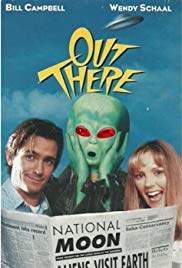
Verdict: Charming.
Beau collects old cameras and finds in one exposed film from August 1969 which he develops in his home dark room closet. Whoa! It’s ‘Paul’ (2011) and his brother Asgards on film. Aliens with bulbous heads like ‘My Favourite Martian.’ What to do?
Well he is a free lance (aka unemployed) photo-journalist so he tries to sell the pictures. Editors dismiss them as fakes. He takes them to the Air Force where Chief Gillespie reads him the official word on UFO-riding aliens. Gillespie played the same bumptious fool in ‘Mars Attack’ (1996) discussed elsewhere on this blog. Do I see the hand of the IRS compelling this old stager on to the old stage, again and again?
Then Prince Nerd comes to his door with a thousand smackers for the pictures for his personal UFO collection. Bingo!
Beau soon discovers that Prince Nerd is a paid Liar, that is, he works for Faux News which has plastered the pictures along with Beau’s own countenance across the nation. Faux News blames the aliens on Hillary and this makes Beau a laughing stock.
Righteously indignant he goes to sock Prince Nerd where he meets Frail, who is the daughter of one of the men pictured with the aliens. Her dad and his pal disappeared that very night in 1969. She was there to find out what happened to Dad.
The two join … forces to figure it out. They meet a relentless real estate agent for whom ‘NO!’ is a bargaining gambit, an accordion playing retired football star, UFO nuts who begin to seem sane, some cagey trailer trash, and — well, yes — some aliens without bulbous heads. They read micro-cards, interview witnesses, explore dark houses, and find bright lights. That’s entertainment!
It is slow, low key, shorn of special effects, not a CGI in sight and relies on the droll script and the deft players to move things along. The direction gives it a gentle pace. Accordingly, mouth-breathers score it at 1 or 2 on the IMDb. Ah the benefits of a free public education wasted again.
Way over budget are some of the players, including Jill St John, Billy Bob Thornton, and Rod Steiger along with Mr Hom.
Category: Film Review
‘The Cremators’ (1972)
IMDb runtime of far too long at 1 hour and 15 minutes, rated a generous 2.2 out of 10 by 229 slackers.
Genre: Sy Fy and Boredom.
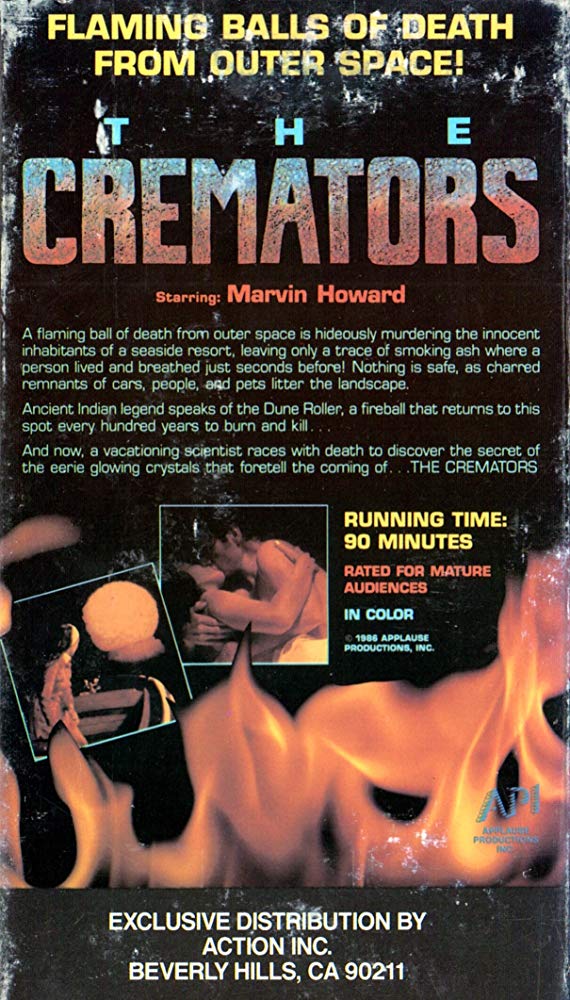
Verdict: So bad that it’s bad.
A flaming orb lands on Earth and after toasting an Indian or two it then hides in a lake for three hundred years. That prelude took fifteen minutes as we watch the same segment of the Indian running down a hill in a five minute loop.
A geologist digs up some opals which stimulate the flaming orb which has been Rip Van Winkle-ing at the bottom of the lake. Yes, the flaming orb was hiding in the bottom of a lake. Cute trick. Awakened, flaming orb toasts various people in the hills.
No one finds this strange because the Surgeon General has said smoking kills. And where there is smoke there was fire. Great logic that.
The geologist and his squeeze investigate since the authorities are too busy practicing their bumpkin accents.
The flaming orb lurks around keeping an … [a what?] on Geologist in between toasting others. Why flaming orb does not toast Geologist and spare viewers more treacle is unknown.
Consulting the NRA play book, victims try shooting the flaming orb. More toast is the result. Finally Geologist figures out something or other and finishes off flaming orb. At last.
What the orb was, what it was doing, and who cares all are questions left unanswered.
It is a Roger Corman production. Hmmm. It is poorly lit so most of the scenes are lost in the murk. The editing destroys continuity. The acting is … well, it is the first and last credit on the IMDb for most participants. The direction is absent.
Director Harry Essex wrote two excellent screen plays: ’The Creature from the Black Lagoon’ and ‘It came from Outer Space.’ Each is discussed elsewhere on this blog. He also wrote this slop. Naughty Harry!
That inflated 2.2 includes several 8’s from raters who rated it so bad it is good. Imbecilic but true.
‘Saint Ex’ (1996)
IMDb meta-data is run time of 1 hour and 22 minutes, rated 5.4 by 144 cinematizens.
Genre: Bio-pic and Disappointment
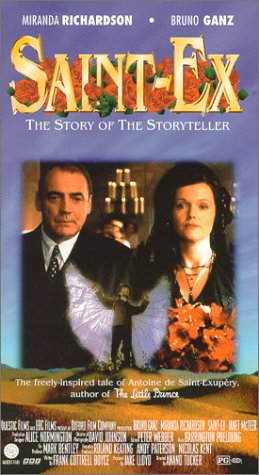
Verdict: Read the books.
Antoine Marie Jean-Baptiste Roger, comte de Saint-Exupéry (1900-1944), just wanted to fly, and fly he did. In 1908 he saw his first airplane and seldom had eyes for anything else after that.
Bruno Ganz plays Saint Ex, as he was called even by his sisters. He had a vexed relationship with Consuelo and that is the focus of this film where she is played by Miranda Richardson as a selfish, manipulative, petulant woman with no interest or activities of her own part from making him miserable. Blame the screen writer.
Ganz and Richardson were enough to capture my interest, plus the prospect of some flying sequences. But alas, the actors have little to do, though they try their best to make the most of it, and the flying sequences. Well, what flying sequences? We had a better flying sequence against a green matte in Amsterdam once making a tourist video. What we see here is clumsy, patently fake, and all too much like a school play.
Moreover the story dwells on ‘The Little Prince’ from go to whoa as his alter ego, though in fact he tossed that off in a few weeks while travelling the United States to raise money for Free France. It was not a lifetime preoccupation as implied here.
By concentrating on ‘Le Petit Prince,’ the story elides and ignores most of his career as a world travelling aviator, international journalist, and published novelist. Occasionally some passages from his elegiac prose are narrated, and that is the best part of the film because it communicates a feeling for the sky, the wind, the earth below, and the eternity of the stars. But alas, there is too little of that.
Try ‘Southern Mail’ (1929), ‘Night Flight’ (1931), ‘Wind, Sand, and Stars’ (1939), and ‘Flight to Arras’ (1942).
 This is the last photograph of Saint Ex.
This is the last photograph of Saint Ex.
It has Ganz declare in the last scene that he is a ‘fighter pilot.’ Not so, he flew reconnaissance and the Lockheed P-38 he had was unarmed, despite appearances in this movie, to make it lighter for distance and speed. It was also a notoriously difficult plane to fly even for pilots trained in its peculiarities with youthful reflexes, unlike the forty-four year old St Ex. Did he have a self-destructive streak? Perhaps.
The archival interviews with people who knew him are informative, though at the end when the credits roll the camera work on some of them is demeaning and gratuitous. Really!
There are no linked critics and no user reviews on IMDb. Never before have the opinionators failed to fill a vacuum on the IMDb. However, all was not lost because the entry on Amazon for the DVD is accompanied by some idiotic comments, including one that has Saint Ex dying to prevent Charles De Gaulle from making France socialist. Don’t believe me. Look for yourself. It restored my faith in the endurance and proliferation of human idiocy.
‘The Hideous Sun Demon’ (1958)
IMDb runtime is 1 interminable hour and 14 elastic minutes that stretched and stretched, rated a generous 3.9 by 980 spaced out viewers.
Genre: Sy Fy, Boredom
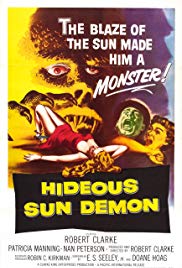
Verdict: Why did I do it?
Robert Clarke’s allergy to shirts continues in this exercise. Playing (off camera) with atoms he exposes himself (see reference previously to no-shirt) to radiation and is rushed (ever so slowly) to a hospital where he seems….. like Robert Clarke, i.e., shirt on, shirt off.
It is quickly discovered that if he is exposed to sunlight from the big nuclear reactor in the sky (N.B. as soon as Greens figure out it is a nuclear reactor, they will want to close it down), he gets all rubber lizard-suited in the tradition of cheapie Roger Corman movies. He goes all nasty, ripping, tearing, chasing, killing, devouring, all within the Hollywood code. (The only Hollywood monster permitted beyond the code was HUAC.) This is not something he likes but he has no control once he is sun burned. Sort of like the fraternity brothers after the second keg.
The reptilian Clarke is an instance of reverse evolution, explains one doctor (ever so slowly for those taking notes). HE MUST AVOID SUNLIGHT AT ALL COSTS.
Guess what comes next! He gets sunlit and goes all reptilian like a Senate Republican leaders.
Not even the Hollywood police, who have seen it all, they thought, can ignore this. Off they go in a chase that goes on, and on, and on, and on. He is an incompetent runner and they are KeyStone Kops without the laughs.
As entertainment, well,….. The Fast Forward is the viewer’s friend.
Shirtless Clarke was the producer, director, writer, and star, and one critic linked to the IMDb entry says it was filmed in his home for a $5000 (app. $43,000 today). The word is most of the players were friends and family who worked for the absolute minimum. It all shows. It was his first and last effort of this kind.
When Lon Chaney, Jr became the Wolf Man that story and that actor endowed the metamorphosis with pathos, loss, anger, distress, resignation, and confusion. What we have here is bathos. (Look it up.)
The lizard suit is pretty much it. Although the fraternity brothers liked the bar scenes. Typical.
On the IMDB Clarke has a long list of credits (many where the B movie budget did not run to a shirt), including several films discussed elsewhere on this blog: ’The Man from Planet X’ (1951), ’The Astounding She Monster’ (1957), ’The Incredible Petrified World’ (1959), and ‘Beyond the Time Barrier’ (1960). Mostly his later entries are in television, many uncredited.

He was movie struck as a boy in Oklahoma and went to California to be discovered. When John Agar was in the tank, Clarke got the nod, it seems.
‘Salyut 7’ (2017)
IMDb meta-data is runtime 1 hour and 51 minutes, rated 7.2 by 5708 cinematizens.
Genre: Docudrama.

Verdict: Wow!
During the Cold War in 1985 with Ronald Reagan in the White House and Mikhail Gorbachev in the Kremlin, the Soviet space station Salyut 7 (S7) went haywire. During a period when it was unoccupied, S7 lost flight integrity and began to spin on all three axes in a way that threatened a crash on earth. There was no way to control it from the ground.
Time to send in the flyboys. Their mission is to fix it or destroy it. A crash would be terrible but even worse would be a capture of the space station by the irritating and tiresome Americans. If they used a space shuttle with a Canadarm to grab the station, then they would have all the latest Red technology on board, coffee cups, screw drivers, burned out oxygen canisters, pinup pics of Comrade of the month, and so on.
There are the complications, of course. One of the flyboys was grounded but the engineer chosen for the assignment wants him back. Why, we never find out. That he was grounded is the start of the film, and let’s just say it reminded me of something John Glenn once said, and wisely never repeated. But it means that this flyboy is not high on the short list of those trusted. The Ground Control commissar (Cap Con in NASA-speak) has to fend off military and political pressures which mount up.
The two have a deadline to meet, which was set both by the erratic orbit of S7 and the American salvage hunt. To add spice, each has a crisis of sorts in his personal life. Whew, what a lot of competing story lines.
Off they go!

This is one of the arresting visuals as the rocket ship pierces the clouds and leaves earth.
It is the usual management squeeze: they are told to use their initiative but to obey orders. They are told to use their own judgement but wait for directions from Cap-Con. The McKinsey management manual has a Russian edition.
Anyone crazy enough to go on this mission has to be crazy enough to see it through and they do, not always obeying orders and not always waiting for instructions. They see the job and do it.
Nits to pick there are a few. If the Red Tech is so hot how come earlier they let that French astronaut on board and then let him go to work for the Americans. Hasn’t he already told all. Most Frenchmen do. This Frenchie is mentioned early on and then forgotten, though not by this correspondent.
The international irresponsible media makes much of the problem, but all examples of this perfidy we see come from beyond the Soviet sphere. Inside Russia no one knows what is going on or so it seems.
Wow! The special effects are very special. According to the film publicity about twenty minute of screen time came from S7 in space. Fabulous. Another forty minutes came from cosmonaut training. Verisimilitude is high. The travelling mattes for the space photography are glorious. Far too few space film have anything of the grandeur and emptiness of space in them, but this one does.
The gorgeous photography brought to mind ‘Gravity’ (2013) but this film had a story, whereas ‘Gravity’ had only Sandra Bullock taking her clothes off, repeatedly. The fraternity brothers rated is 6 out of 5. (That’s their idea of wit.)
The exploits of the cosmonauts are there, but played in a low key, and the better for it. The emphasis is always on doing the job, and how hard it is with all those laws of physics. This is what has to be done. Do it.
I also like the distribution of heroism between the two flyboys and the Cap-Con on the ground. They each had a role in making it happen. And nothing is soft-soaped.
What is not to like is the role of women. The only woman in action we see is there to be rescued from herself in the opening. Thereafter the only women we see are the wives, who are treated condescendingly by everyone. There is an MD at Ground Control who is constantly ignored and patronised. No doubt realistic, but rankling all the same. Marie Windsor would not have put up with that. See the discussion of ‘Cat-Women of the Moon’ (1953) elsewhere on this blog for edification.
I expect the film is no more realistic than ‘Apollo 13’ but it is great entertainment. But with all those competing storylines something had to give, and some of the elements are lost in the shuffle. It should have been cut to 90 minutes as the laws of physics demand. In this case, the physics of me sitting still and reading subtitles.
‘Night of Terror’ (1933)
IMDb meta-data is runtime of 1 hour and 5 minutes, rated 5.7 by 307 cinemitizens.
Genre: Horror, Mystery
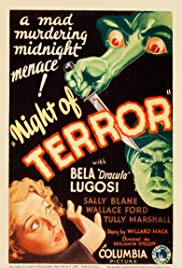
Verdict: Not enough Bela!
At the Rinehart estate, upstart Beau is a scientist who is about to experiment on himself by slowing his bodily processes to nearly nothing to be buried alive, and then dug up later. Nutso, right? Right! On the other hand think of the market for a drug that could do that. Before every McKinsey management training session with a twelve-year-old trainer the victims, the old salts, could deaden themselves to the nonsense and revive at the end. Hmm, sounds good, but back to the film at hand which does not sound so good.
Outside a Maniac is murdering so many people that the fraternity brothers ran out of fingers.
Meanwhile, the faithful servant Bela Lugosi peers around corners, creeps down hallways, probes into recesses. Is he the Maniac? No, we know he is not from the opening scene and that steals much thunder from the get-go.
Because they are wealthy and beautiful the Rineharts suppose they are safe. Just before being murdered they say ‘I’ll be all right.’ They aren’t. Did Hillary do it? Who insured their lives? Fired!
Yes, Maniac finds rich pickings in the Rinehart mansion on the Rinehart estate on Rinehart Drive in Rinehartville. Dad Rinehart is murdered and his will divides his fortune equally among the surviving relatives. That is not enough for any of them, and they fall to bickering, and cheer Maniac on when he murders again.
Bela continues to peer. His mystic wife goes into trances at the drop of a knife. Yet the proceedings are lugubrious. Then the comic cop shows up in the pre-code film where the police were often the comic distress. After the Hayes Code police had to be portrayed positively in works of fiction.
There are some fine players like Wallace Ford as the cynical newsman who injects energy, and Sally Blane, aka Loretta Young’s little sister. Even Beau is well played by George Meeker who is just too oily to be true.
Turns out Beau had a plan of his own, and it did not involve lying quietly waiting to be disinterred but how he managed to combine that with Maniac is anyone’s guess. The screenwriter did not even try to cover that. Bela was but a red herring. What a waste of this master of menace.
‘Star Quest’ (aka ‘Terminal Voyage’) (1994)
IMDb meta-data is runtime 1 hour and 19 very l o n g minutes, rated at an inflated 4.4 by 238 relatives of the director.
Genre: Sy Fy and Bickering
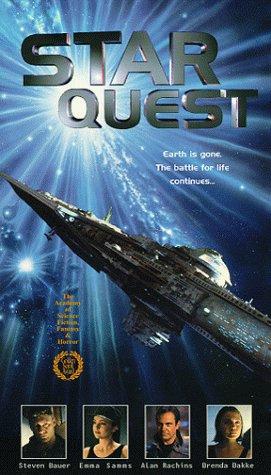
Verdict: It felt terminal.
In distant 2035 an international crew of bickering, backbiting, resentful slackers rides a spaceship to find a new home for the residents of the doomed planet Earth. These are the Bickersons and the fate of the species is in their hands. Game over.
What selection process picked this crew? Spin the bottle? Eenie, meanie, minnie, moe? Or were they the survivors of McKinsey management seminars? No, no one survives those.
The Bickersons awake from a cryogenic sleep – the scriptwriters best friend after the meteor shower — and find the low bid contractor struck again. The captain of the ship is a rotten corpse. Maybe he read the script and took the easy way out.
Thereafter others exit. First the 2-IC (that is, second in command for the pacifists) steps up to the plate. Briefly. Now that he is in the big chair his butt print (the fraternity brothers suggested that image) allows him access to super secret intel. He reads the script and…. Yes, he hung himself in a hallway. So far nothing has happened but the payroll had diminished. Every managers dream come true.
Then the only one who seems to be taking his lines seriously snuffs it while wearing a virtual reality hood to watch a peep show. Meanwhile, others are doing a variety of pharmaceuticals. The snarling Russian in the ranks smokes oxygen burning cigarettes. Sure. That would be a good idea. The fraternity brothers waited for her to don a space suit and light up!
This crew has been carefully selected from the world’s population and this is it! It looks like President Tiny’s inbred cabinet of dolts, droolers, and dopes.
Then there is the automaton who even in death is irritating. Androids can be like that. Even the severed head of the android has been done in ‘Spaceflight IC-1’ (1965) discussed elsewhere on this blog.
It is by the numbers. The dead captain was dramatic in ’Planet of the Apes’ in 1968. The virtual reality was done to death in Star Trek. The drugs have been everywhere. These people did not need a spaceship for such banalities. The mechanical man, a woman in this case, is another tired trope stitched in.
It is all interiors. We never even get a glimpse of the stellar void, or any sense that the space ship is going anywhere or that the Bickersons have any control over it, though we get far too many shots of its vast CGI bulk.
Most of the action is the crew arguing about who is in charge. That part did seem realistic because pointless bickering is on most agendas. They snipe at each other. Denounce one another’s national origins and dress sense. The usual. No need to go into space for any of this.
And they didn’t. The end.
The Italian Sy Fy of the 1970s at least had some energy. Not so here. The direction is leaden. The screen play has no redeeming merits. The set is a card table. Within those limits the actors try to work up some drama, well, some of them do, and others keep looking at their watches. Me, too.
‘Los autómatas de la muerte’ (or ‘Neutron the Atomic Superman vs. the Death Robots’) (1962)
IMDb meta-data is runtime of 1 hour 20 minutes, rated 4.4 by 95 cinematiziens.
Genre: Sy Fy, Mexican
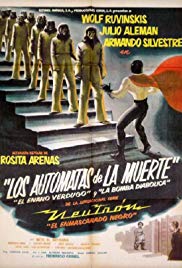
Verdict: Lucha libre!
While auditioning for Eggheads, Dr Caronte keeps three dead brains in his cupboard. They are hungry little grey cells and he sends a horde of bearded zombies in boiler suits to the Red Cross to take, not give, blood for these critters. Musical interludes punctuate the pace.
To confuse matters Caronte often wears white, while the bare chested, tireless battler for truth, justice, and the tamale-way, Neutron, wears black. Got it so far?
Neutron has a way of appearing and disappearing. Whoosh. There he goes again, or here he is again: Whoosh.
The action takes place in a darkened Mexico City alley, and in the director’s home, and on a sound stage nightclub. Many expenses were spared. The dubbing is terrible, befitting the picture. Still all and all, it is better than some early Roger Corman efforts and less predictable than anything on broadcast television.
Neutron does the lucha libre with the zombies, who are directed by a dwarf who can barely lift a revolver and runs like…..a dwarf, and not a CGI.
It seems Neutron and Caronte have a history in a series of the movies, four or five, but who’s counting.
Wolf Ruvinskis stars as the man without a shirt but with a mask and a Whoosh. He was a Lativian Jew whose family fled the Naziis. In the new world, as a teenager, he became a lucha libre champion and that took him to the heart of the sport, Mexico City, where he stayed. One thing led to another and when the falls got too hard to fake, he kept the mask to extend his career as Neutron. (Pretty sure that the physiotherapist I go to learned the trade at lucha libre.)
Amazon Prime tempted me with this offering, and it seemed better than some of the alternatives from Hollywood of late. At least it was not pretentious, did not present fiction as fact, or have Jack Black in it. Three pluses right there. Though admittedly the part of the dwarf would fit Tom Cruise.
‘Eyes in the Night’ (1942)
IMDb meta-data is runtime of 1 hour and 20 minutes, rated 6.8 by 992 cinemtizens.
Genre: Mystery, Canine.
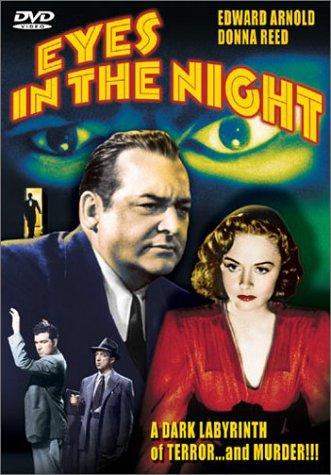
Verdict: A fast start and and fast finish, but in between time passed very slowly.
Veteran supporting actor Edward Arnold plays the lead as a blind detective in the first of a short-lived series of B pictures. He is ably supported by an excellent cast and it starts well.
Eddie has his Alsatian, Friday, to look after him and Allen Jenkins to do the heavy lifting in-between pratfalls, while Mantan Moreland opens and closes doors and his bug eyes. These latter two share the comic distress duties.
An old (girl) friend (hereinafter designated OGF) comes to ask for his help, because her step-daughter Donna Reed (sigh…, went the fraternity brothers) is in love with a gigolo twice her age. What Eddie and company can do about this domestic tangle is anyone’s guess. He tells her to have it out with Gigolo.
OGF takes his advice. (What a sucker, cried the fraternity brothers.) She finds Gigolo cold and dead on the bear rug in front of the fireplace in his bachelor pad. Gulp! She goes back to Eddie, who sets out with Friday and Jenkins for reasons unknown, but a private dick has to do what a private dick has to do, per the script.
OGF’s husband is the incredibly dignified Reginald Denny, a scientist working on a TOP SECRET project that he keeps in his clothes closet at home. Security or what? Or what. He is away being important leaving OGF and Donna at home to tear strips off of each other with a houseful of recently employed servants with foreign accents. Will the clothes closet b safe? The tension did not mount.
So far it has some pace and mystery, but about now occurs a hissing sound that is the air leaving the balloon.
All of the many servants at the house are Nazi spies so incompetent they have not yet found the closet and purloined Reggie’s secret. Donna’s friends who encourage her to antagonise her step-mother, i.e., OGF, are also Nazis. They are everywhere. Friday even looks under the bed for more. The top Nasty is Katherine Emery who gives a masterful performance as a black widow.
Once Eddie is ensconced in the house, the action freezes. He carries on as best he can with the screenplay but really…. He plays the organ; he paces in garden; he listens at doors; he plays the organ some more; he paces in the garden; he listens at doors. Then for a change he repeats the sequence. It was a very long night. And so on.
[It is no surprise to any observer of the absurdity of life, that some IMDb reviewers think the interminable scenes at the house with Eddie playing the uncle are great. Me, watching paint dry would be better.]
The Nasties take him for a fool, underestimating him because he is blind. That is a neat idea but it just does not gel in this rendering. He has some nice lines like this one: ‘Turn out the lights, I am going to read.’ Did he have a Kindle, too? No, he had Braille.
There is a superb confrontation in a darkened cellar where the blind man has the edge, and it is staged and directed with real suspense. Fortunately for the Eddie the Nasties have been knocking each other off to reduce the budget so he does not have to deal all of them at once. Meanwhile Friday shows off his canine athletic ability racing here and there, completing a crossword puzzle on the run. It all comes good in The End.
A second was made but it, too, had a cool reception, perhaps there were too many blind men coming home for the war for it to be diverting. There is a large ensemble cast on show here and many went on to bigger and better things, including Rosemary de Camp, John Emery, Ann Harding, Steven Geray, Stephen McNally, and Barry Nelson in addition to those named above.
But the biggest name is director Fred Zinnemann whose list of subsequent credits runs to: ’Member of the Wedding’ (1952), ‘High Noon’ (1952), ‘From Here to Eternity’ (1953), ‘A Hatful of Rain’ (1957), ‘Behold a Pale Horse’ (1964), ‘A Man for All Seasons’ (1966), and more.
‘X the Unknown’ (1956)
IMDb meta-data is runtime 1 hour and 24 minutes, rated 6.2 by 2,242 cinematizens
Genre: Sy Fy
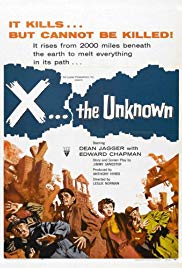
Verdict: A known unknown, to quote Donald Rumsfeld. with whom I once crossed a street in D.C.
A British Army unit practices detecting and securing radium watches on a mired, desolate beach. These are national servicemen who are none too keen on this damp, wet, and muddy duty so they slack off. Then one of them gets burned to a crisp. Now that might stimulate some attention, but no they continue to smoke, rest, and generally act by film extras. More crispy critters are on the menu.
Turns out the practice radium has lured a radium eating blob from deep within the screen writer’s imagination to the surface.
Officialdom reacts according to the McKinsey management manual by denying reality, by blaming the victim(s), by minimising the loss, by claiming pilot error, by blaming Hillary and so on. But the plot must thicken to make a movie. Nearby is a nuclear research centre and also a nuclear power station, plus all those radium dials on watches that were fashionable at the time. In short, it is a picnic ground for the blob from the deep whose appetite has been stimulated.
A couple of adventuresome boys are toasted and the parents blame science, not stupidity. Got it.
Rumpole arrives to investigate and seeks out Baldy, who gets all serious. Baldy is the American import straight from Jefferson High School where he used to supervise Mr Novak. Baldy and Rumpole team up and tame the blob with some mumbo-jumbo, aka science. Blob retreats but will it come again, and what was it anyway? X as above.
The pace is snappy. The atmosphere is effective. The blob is largely unseen and all the more menacing for that. Baldy is authoritative without being arrogant. Rumpole is persistent without being obnoxious, contrary to the current rule of Hollywood.
The tagline on the poster above is ‘It can kill but cannot be killed.’ Why did I think of McKinsey management training sessions? Is this another unknown? Dunno.
Steve McQueen must have gotten a few tips from this picture when he encountered his own blob.
The screenplay was originally intended to continue Hammer Films run of success with Professor Quatermass. However, Nigel Kneale, who owned the copyright to Quatermass, would not relinquish it, i.e., not enough dosh was on offer, and so Baldy was re-named.
As is sometimes the case, there is more drama behind the camera than in front of it. Hammer had hired Jospeh Losey to direct.
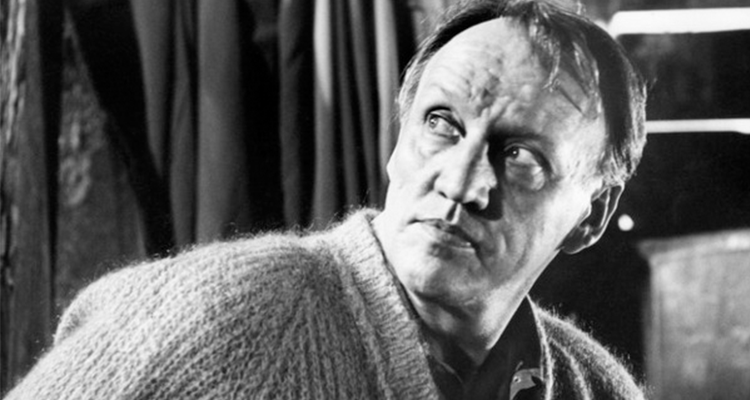
He went on to do many superb films like ‘The Servant’ (1963), ‘The Go Between (1971), ‘Mr Klein’ (1976), and many more.
However, Baldy refused to work with Losey. Losey had escaped the monster that roamed 1950s Hollywood, HUAC, while Baldy was a 100% Moron who would have nothing to do with this pinko. Either he goes or I go, he is supposed to have said. The producers made the wrong call and kept Baldy.
They got lucky though because Leslie Norman did a fine job of filling in as director at short notice. He went on to be a regular with ‘The Avengers.’ The screenplay by Jimmy Sangster is low-key and lets the action carry the story. There is no exposition. No effort to make anyone sympathetic with a boring backstory. He cranked out many a story for Hammer over the years.
